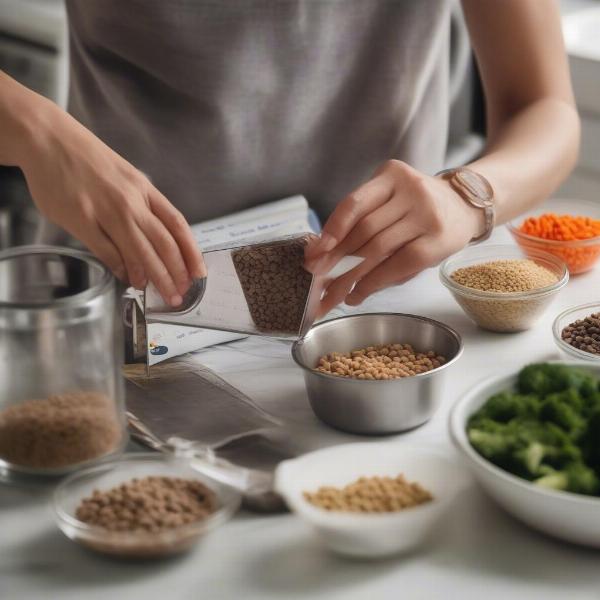The dreaded phrase “dog food shortage” can send shivers down any dog owner’s spine. Whether you’re facing empty shelves at your local pet store or simply concerned about potential disruptions to your dog’s diet, understanding the causes, navigating the challenges, and finding solutions is crucial. This article will equip you with the knowledge and strategies to keep your furry friend happy and well-fed, even during times of scarcity.
Understanding the Causes of Dog Food Shortages
Several factors can contribute to a dog food shortage. Supply chain disruptions, ingredient scarcity, increased demand, and even natural disasters can impact the availability of your dog’s preferred brand. Knowing the root causes can help you anticipate potential shortages and prepare accordingly. For instance, a widespread drought might affect the production of certain grains used in dog food, while logistical challenges can delay shipments and lead to temporary shortages.
One key aspect of understanding a shortage is recognizing the difference between a true shortage and a perceived one. Sometimes, a particular brand might be temporarily unavailable due to logistical issues, while other equally nutritious options are readily available. Don’t panic! Take a deep breath and explore alternatives.
Practical Tips for Dealing with a Dog Food Shortage
Facing empty shelves can be daunting, but proactive steps can alleviate stress and ensure your dog stays nourished. Start by checking with smaller, independent pet stores. They may have different supply chains and stock less common brands. Online retailers can also be a good option, although shipping times might be affected during widespread shortages.
Consider gradually transitioning your dog to a new food to avoid digestive upset. Mix a small amount of the new food with the old, gradually increasing the proportion of the new food over several days. This allows your dog’s digestive system to adjust.
Exploring Alternative Food Options
If your dog’s usual food is unavailable, consider exploring alternative brands or even homemade dog food recipes under the guidance of a veterinarian. Look for foods with similar nutritional profiles to ensure your dog receives the necessary vitamins and minerals.
 Preparing homemade dog food
Preparing homemade dog food
Remember, a temporary change in diet is unlikely to cause long-term harm as long as the new food is nutritionally complete and balanced. Consult your veterinarian for personalized advice and recommendations based on your dog’s breed, age, and health status.
Preventing Future Food Stress: Planning Ahead
The best way to manage a dog food shortage is to be prepared. Keep a two-week supply of your dog’s regular food on hand. This buffer provides time to find alternatives if your preferred brand becomes unavailable. Explore different brands and identify a few suitable backups. Knowing you have options can reduce stress and ensure your dog’s nutritional needs are met.
Conclusion: Keeping Your Canine Companion Well-Fed
Navigating a dog food shortage can be challenging, but with careful planning and a proactive approach, you can ensure your dog stays healthy and happy. By understanding the causes of shortages, exploring alternative food options, and preparing ahead of time, you can minimize the impact on your furry friend.
FAQ:
- What should I do if I can’t find any dog food? Contact your veterinarian. They may have suggestions for alternative food sources or be able to connect you with local pet food banks.
- Can I feed my dog human food during a shortage? Some human foods are safe for dogs in moderation, but a balanced, complete dog food is essential for their long-term health. Consult your vet for guidance.
- How long can a dog go without food? While a healthy adult dog can technically survive for several days without food, it’s not recommended. Consult your vet immediately if your dog hasn’t eaten in over 24 hours.
- How do I transition my dog to a new food? Gradually introduce the new food over several days, mixing it with their current food in increasing proportions.
- Where can I find reliable information about dog nutrition? Consult your veterinarian or a certified veterinary nutritionist for personalized dietary advice.
- Is it safe to make homemade dog food? Homemade dog food can be healthy, but it requires careful planning and balancing of nutrients. Consult your vet or a certified veterinary nutritionist for recipes and guidance.
- How can I avoid panic buying during a shortage? Keep a two-week supply of your dog’s regular food on hand and avoid stockpiling unnecessarily.
Related Articles:
ILM Dog is your trusted source for expert advice on all aspects of dog care, from breed selection to nutrition and training. We provide comprehensive resources and practical tips to help you navigate the joys and challenges of dog ownership. Whether you’re a seasoned dog parent or just starting your journey, ILM Dog is here to support you. Contact us today for personalized guidance and support! Email: [email protected] Phone: +44 20-3965-8624.